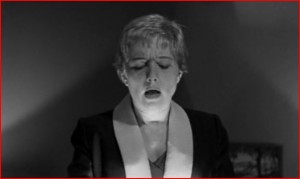The moment I watched Gabrielle open the mysterious box in Kiss Me Deadly, unleashing a possible apocalypse in the process, I suddenly remembered that I had once seen a movie with a similar box before. After briefly googling, I found that similar case to be in Quintin Tarantino’s Pulp Fiction. In both movies, there is a case with unknown contents which glow brightly upon opening. While the contents are never revealed, they are implied based on the descriptions of them and the emotions that they arouse in the characters. It is the fact that the contents are never revealed, which leads me to believe that both mysterious boxes are defined not by their contents, but rather by the emotional responses of the characters that seek them.
 In Kiss Me Deadly, almost all who sought to retrieve the case ended up dead. Mike Hammer only survived after realizing that its contents are more serious than he could handle alone, and that he should hand it over to the police, thereby ending his desire for the box. While the contents of the case are never revealed, it is assumed to be a kind of dangerous atomic energy. Released during the Cold War, this movie is an example of the public’s general fear of a nuclear apocalypse.
In Kiss Me Deadly, almost all who sought to retrieve the case ended up dead. Mike Hammer only survived after realizing that its contents are more serious than he could handle alone, and that he should hand it over to the police, thereby ending his desire for the box. While the contents of the case are never revealed, it is assumed to be a kind of dangerous atomic energy. Released during the Cold War, this movie is an example of the public’s general fear of a nuclear apocalypse.
Pulp Fiction’s mysterious case is far less lethal in contrast, but causes the same sense of desire in characters. To briefly summarize the movie without spoilers, Pulp Fiction tells the story of a number of individuals involved in a criminal network led by Marsellus Wallace. The suitcase makes several appearances throughout the movie, carrying with it the same mystique as the one in Kiss Me Deadly. The contents are never revealed, as with Kiss Me Deadly, and those who seek to possess it generally end up dead as well. There is much speculation on what the box actually contains. The Toronto Star even held a contest to determine what was in the box. Though there is only speculation, as the director insists that the suitcase serves merely as an interesting plot device, the most widely accepted interpretation is that the box contains Marsellus Wallace’s soul. It is believed that the boss of the criminal network sold his soul to the devil, and is attempting to buy it back. There are a number of clues that lead to this conclusion, such as the strange bandaid on Marsellus’s head, the suitcase with “666” as its combination, and the supposed miracle which protects two hitmen who seek to reclaim the box. In Tarantino’s film, the contents of the case are so beautiful and valuable that all those who see it, wish to keep it for themselves. It is important to note that the original contents of the box were to be diamonds, but were removed from the final cut of the film. Perhaps in that case, the suitcase would have served as a symbol of financial greed.

While the contents of both boxes are never known, they both have an aura of mystery around them, causing characters to seek them, and often die trying. Other than both having luminescent contents, both cases are defined by the emotions which they arouse in the characters of the movie, as their contents are never really known. Though no concrete conclusions may be made, I found the similarities of both movies interesting enough to warrant a blog post.
As I recall, Quentin Tarantino has said that the brief case in Pulp Fiction is an homage to Robert Aldrich’s Kiss Me Deadly. Like the French critics Naremore talks about, Tarantino seems to regard Kiss Me Deadly as the quintessential B noir, one which still resonates with audiences perhaps more significantly than some of the more standard films of the mid to late 50s. It’s fascinating to me how movies like Kiss Me Deadly and Touch of Evil which were largely rejected by audiences and critics when they were first released have since become hugely important, influencing a younger generation of filmmakers who have incorporated some of their most memorable elements into their own films. The briefcase from Kiss Me Deadly is a great example.